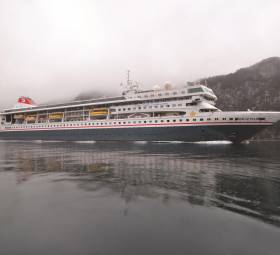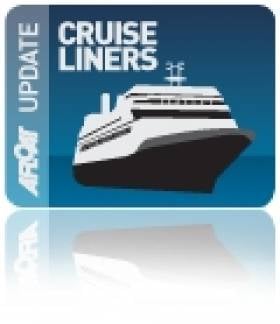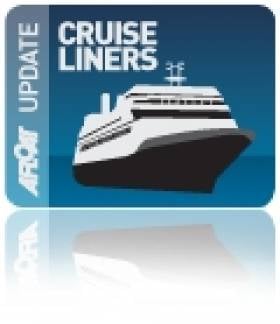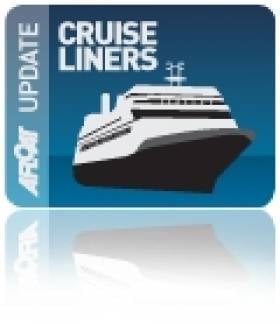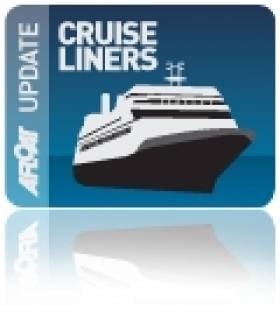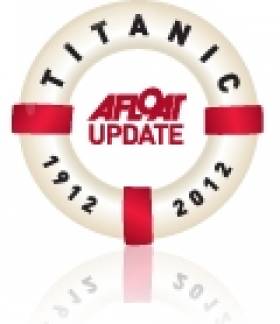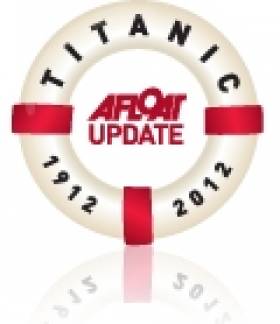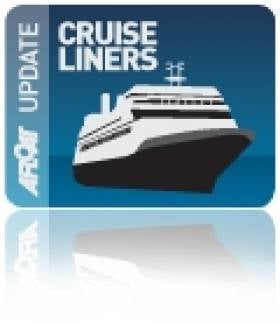Displaying items by tag: Fred Olsen Cruise Lines
Cruiseship's Second Inaugural Irish Sea Port of Call
#CruiseFirsts - Irish Sea port of Barrow-in-Furness, operated by Associated British Ports / ABP Ports welcomed the largest cruise vessel ever to call to the Cumbrian port in north-west England.
MS Braemar became the second cruiseship to visit Barrow in the last two months, when the Fred. Olsen Cruise ship made an inaugural call last Friday. The 196m in length cruiseship which too made a first call to Rosslare Europort last month, can accommodate over 900 passengers, making it the largest cruise ship to visit since the port’s first cruise call in 1995.
While cruise ships are today not a regular sight at the Port of Barrow, the port has a long association with the industry dating back 100 years, including when the then Vickers-Armstrongs shipyard built the ‘Strath’ Class Liners for the Peninsular & Oriental Steam Navigation Company (P&O) in the 1930s.
Port Manager Paul Jervis said: “The Port of Barrow is best known today for its role as a base for manufacturing submarines. However, the arrival of MS Braemar, following the visit of the Saga Pearl II last month shows that the port is capable of handling a wide variety of vessels for different customers.
“The benefit of hosting cruise vessels here at Barrow is that we are able to showcase Barrow and the Lake District area to tourists from all over the UK and the world. It boosts the region’s profile and tourist numbers, and will provide economic benefit to the local communities.
“The area has a lot of attractions to entice cruise companies and their passengers. With the port well equipped to handle cruise calls, we hope to see more cruise ships at Barrow in the future.”
Scheduled shore excursions included tours of the Lake District and free shuttle buses available to take passengers to local attractions like the Dock Museum and Furness Abbey.
Fred Olsen’s Boudicca to Get New Balconies
#BoudiccaBalconies - Fred. Olsen Cruise Lines’ 880-guest Boudicca is currently undergoing refurbishment in a drydock at Lloyd Werft's shipyard in Bremerhaven, Germany, in preparation for the forthcoming 2016/17 cruise season.
The 28,55I tonnes Boudicca docked in Bremerhaven last week from the Port of Tyne, Newcastle, following a 16-night ‘Mysterious Morocco & Seductive Spain’ cruise. The same North Sea port is where Boudicca had completed a round trip cruise themed ‘Myths & Legends of Ireland & UK’ as previously reported on Afloat.ie.
During the dry dock, Boudicca will also see 28 cabins on Lido Deck 7 fitted with terrace balconies. These new terrace balcony cabins will extend out 1.2 metres from the ship’s bulkhead, and will provide guests with an increased choice of cost-effective balcony cabins, with access to the outside.
In addition, Boudicca will undergo various engineering work, general refurbishment and interior and exterior painting.
Mike Rodwell, Managing Director of Fred. Olsen Cruise Lines, said: “We experience extremely high demand for balcony cabins across our fleet, in particular on a smaller-sized ship such as Boudicca, and our new terrace balcony cabins are an innovative response to this.
“We installed the new terrace balcony cabins on sister ship Black Watch during her dry dock last Autumn, and these have proved very popular with our guests.”
Following her dry dock, Boudicca will commence her cruise season from the South Essex port of Tilbury, with a 14-night ‘Landscapes of Morocco, Madeira & the Canaries’ voyage, departing at the end of this month on 30th November.
During the 2016/17 cruise season, Fred. Olsen’s fleet of four ships – Balmoral, Braemar, Boudicca and Black Watch will be visiting a record 253 destinations in 84 countries around the globe.
Festive Fred. Olsen Mini-Taster Irish Cruise Underway
#FestiveMiniCruises – Boudicca (1973/28,551grt) of Fred. Olsen Cruise Lines has this evening departed Dublin Port on a 2 night mini-cruise for Irish passengers bound for Liverpool, writes Jehan Ashmore.
The cruise which departed Ocean Pier is one of several festive 'taster' Irish Sea cruises before Christmas.
Fred Olsen, the four-star operator is offering a choice of 1, 2 and 3 night cruises to attract the Irish market as well as the UK.
Last night, Boudicca departed Liverpool's Cruise Terminal to Dublin to where passengers experienced the Irish capital before embarking this evening with Irish passengers to Merseyside.
The other cruises will have an intinerary to include Belfast, Cork (Cobh) and Liverpool plus en route calls to Dublin to collect Irish guests.
Belfast Harbour Welcomes Return of Fred Olsen Cruise Lines
#BelfastCruises – This Autumn Fred Olsen Cruise Lines is 'bringing the world closer' to the people of Belfast, with three exciting cruise itineraries on board the 880-guest Boudicca.
According to Breaking Travel News, guests will have the opportunity, for the first time since 2007, to embark on a Fred. Olsen cruise from Belfast, without having to endure an expensive flight or long ferry crossing to reach its ships.
Boudicca will be offering a 10-night D1322 'Scandinavian Cities Cruise', departing on 23rd September 2013, a 12-night D1323 'Portugal, Madeira & the Canaries' cruise, departing on 3rd October 2013, and a two-night mini-cruise, D1324 'Liverpool Highlights', departing on 15th October 2013.
As previously reported, Braemar, a fleetmate of Boudicca had called to Dublin and Liverpool over the weekend.
Overnight 'Stretch' for Lengthened Cruiseship
#StretchedShip - Fred. Olsen Cruise Lines Braemar docked in Dublin Port for an overnight visit having departed Dover, the vessel which was stretched five years ago presents a smart sleek profile, writes Jehan Ashmore.
On completion of the mid-section, this led to the cruiseships 19,089 gross tonnage increase to 24,344. The lengthening allowed for additional cabins totalling 485 and this equates to a standard occupancy of 929 passengers. The process also involved installing more lounge space and swimming pools.
After the stretching, this has given the vessel launched in 1993 as Crown Dynasty, a rather distinct profile accentuated by her funnel that is positioned well-aft. This is particularly apparent with this amidships photograph of the cruiseship, where you can scroll and click over each deck for further information about her facilities.
At the stern are five-tiered decks (see introduction of video), which give passengers another vantage space to view the scenery, take in the sea air and sun-bath. These sun decks are more akin to the liner era and as such this feature is increasingly lacking on most modern larger cruiseships.
Liverpool Season Opens with a Cruise to the Canaries
#CruiseLIVERPOOL – Liverpool's first cruise caller of 2013 was Fred Olsen Cruise Lines Boudicca which made her maiden turn around call on Merseyside yesterday, writes Jehan Ashmore.
The afternoon arrival of Boudicca from Portsmouth was completed when she berthed alongside Liverpool Cruise Terminal with the assistance a tug at the riverside quay.
She remained at the facility until departing last night on a "Gardens and Beaches of the Canaries" cruise. The vessels (see web-tracking) first port of call is scheduled to be Arrecife, Lanzarote.
For a list of the Liverpool's cruise callers in which there are more than 40 calls this season, among them being Queen Mary 2, Queen Elizabeth and Celebrity Infinity click HERE.
Olympic Bound Cruiseship On Overnight Dublin Call
#OLYMPIC CRUISESHIP – A cruiseship which is to be used as accommodation ship for key workers during the London Olympic Games is currently on a UK mini-cruise including today's overnight call to Dublin Port, writes Jehan Ashmore.
The cruiseship Braemar (1993/24,344grt) has been chartered by the organisers of the global sporting event for over a month. Around 900 personnel are to use the 195 metre-long vessel as their 'floating' accommodation during the games which is run by the London Olympics and Paralympic Games (LOCOG). Most of the workers will be involved in transportation duties for competitors and officials from 12 July – 15 August.
The vessel is to berth in East London Dock (Albert Dock or King George V) which is close to the ExCel Centre, the exhibition venue which has hosted London Boat Show's over the years, will be used for a number of Olympic events. In addition the location is close to the main transport hub for the Olympic workers and is also nearby to London City Airport.
As a consequence of the cruiseship's 34-day long charter, three cruises have been cancelled by the vessels owner Fred Olsen Cruise Lines.
Guests who were originally booked on the affected cruises on board the Braemar have been offered alternative itineraries. In addition the company provided a goodwill gesture to acknowledge the inconvenience while those passengers who choose not to take up this offer have been given a full refund.
Last month the same owners organised a special Titanic Memorial Cruise which called to Cobh, having completed a mini-cruise to Belfast to mark the historical centenary of the liner's construction at Harland & Wolff Shipyard.
Titanic Memorial Cruise Heads for Cobh
#TITANIC MEMORIAL CRUISE - Following Balmoral's recent call to Belfast in memory of Titanic, the Fred.Olsen Lines cruiseship returned to Southampton where today she started a 12-night Titanic Memorial Cruise which will follow the White Star Line liner's original itinerary that included calling to Queenstown, now Cobh.
Before Balmoral calls to Cobh tomorrow, she is to pass Cherbourg, where the passenger tender SS Nomadic served the liner that layed anchored offshore. The 101 year-old tender was also built by Harlalnd & Wolff and she is undergoing restoration work in Belfast, to read more about her click HERE.
Likewise to Balmoral's Belfast visit, her arrival to Cobh is the inaugural call for this year's season, though her poignant arrival will be two days short of Titanic's call a century ago on 11th April 1912.
On Titanic's second anchorage at Queenstown, this too required tenders to transfer 123 passengers who embarked from the town's pier and of those only 44 survived the disaster. The timber built pier still exists albeit what survives is in a derelict state. There have been calls to raise funds to save the structure as previously reported.
Along the scenic waterfront passengers can take a tour of the town's new Titanic Experience in the White Star Line building, the Queenstown Heritage Story in the Cobh Hertiage Centre and the walking Titanic Trails.
From Cobh the Balmoral will sail across the Atlantic, arriving at the Titanic site on April 14th/15th - exactly 100 years on from this tragic voyage, where a memorial service will be held to pay tribute to the brave passengers and crew who perished on that fateful night.
The cruise will then continue to Halifax, Nova Scotia, the final resting place of many who were on board, before sailing on to New York, the Titanic's ultimate planned destination.
- White Star Line
- RMS Titanic
- Balmoral
- Fred Olsen Cruise Lines
- Titanic Memorial Cruise
- Cobh Cruise Calls 2012
- Belfast Port
- SS Nomadic
- Titanic's passenger tender
- Cruise ship news
- Cruiseships
- port of Cork
- Cobh Cruise Terminal
- Titanic Trails
- Cobh Heritage Centre
- White Star Line liners
- Queenstown,Ireland
- Harland & Wolff
- Nomadic Charitble Trust
Easter Cruisecall to Belfast in Memory of Titanic
#TITANIC – The cruiseship Balmoral not only is the first caller to Belfast for 2012 as previously reported, but her arrival this morning marked more importantly as a cruise in the memory of the R.M.S. Titanic, writes Jehan Ashmore.
Cruise passengers embarked on the Fred. Olsen Cruise Lines ship last Tuesday in Southampton for a mini-cruise which included a call to Liverpool yesterday.
Today passengers where to visit the builders of the White Star Line liner launched a century ago at Harland & Wolff shipyard at Queens Island on the banks of the Lagan.
Adjoining the complex is the Titanic Quarter where the recently opened Titanic Belfast Visitor Experience is making an impression through the iconic landmark, for further details click HERE.
Cruiseship Boost for Belfast
#CRUISE LINERS-Belfast Harbour looks forward to another bumper year as cruise operators are to increase by 32% compared to last year, with 41 cruise ships bringing almost 75,000 visitors to the port.
The following major operators are to visit: Cruise & Maritime Voyages, Fred Olsen Cruise Lines, Holland America Line, Princess Cruises and Saga Cruise and others will dock from far flung destinations.
At over 1km long, Stormont Wharf, will again be the main berth for cruiseships in particular the ability to accommodate an increasing trend in larger class vessels touring the Irish Sea. The wharf was extended in recent years at a cost of £10m and is the longest deepwater quay in Ireland.
To promote Belfast Harbour as a cruiseship destination, the port and the Belfast Visitor and Convention Bureau (BVCB) set up the Cruise Belfast Initiative to market the location internationally.
For further information visit www.cruise-belfast.co.uk and to view the seasons schedule of cruise callers click HERE.


























